A History of the County of Berkshire: Volume 3. Originally published by Victoria County History, London, 1923.
This free content was digitised by double rekeying. All rights reserved.
'Parishes: Tilehurst', in A History of the County of Berkshire: Volume 3, ed. P H Ditchfield, William Page (London, 1923), British History Online https://prod.british-history.ac.uk/vch/berks/vol3/pp329-336 [accessed 19 April 2025].
'Parishes: Tilehurst', in A History of the County of Berkshire: Volume 3. Edited by P H Ditchfield, William Page (London, 1923), British History Online, accessed April 19, 2025, https://prod.british-history.ac.uk/vch/berks/vol3/pp329-336.
"Parishes: Tilehurst". A History of the County of Berkshire: Volume 3. Ed. P H Ditchfield, William Page (London, 1923), British History Online. Web. 19 April 2025. https://prod.british-history.ac.uk/vch/berks/vol3/pp329-336.
In this section
TILEHURST
Tygelhurst (xiii cent.); Tyghelhurst (xiv cent.); Tylehurst (xvi cent.).
The parish of Tilehurst was formerly very extensive, but in 1889 (fn. 1) over 2,000 persons were transferred to the parish of St. Mary, Reading, and in 1894 the tithing of Theale and part of Calcot hamlet were divided from it and formed into the parish of Theale. The present parish contains 3,281 acres; there are 269 acres of woods or plantations and the remainder is nearly equally divided between arable land and grass land. (fn. 2) The greater part of the parish lies at about 200 ft. above the ordnance datum, but it is lower near the Thames at the northern boundary and rises to 299 ft. at Kentwood Hill and still higher to the west in the woods near Pincents Farm.
The subsoil is Woolwich and Reading beds, London clay, chalk, and in the valley of the Thames alluvium. Tilehurst Heath used to cover a large part of the parish, and apparently the Abbot of Reading, as lord of the manor, claimed exclusive right of cutting furze on the heath, (fn. 3) which was carted to Reading for the use of the monastery.
The River Thames forms the north-eastern boundary of the parish. The Great Western railway main line runs through the parish parallel with the river; Tilehurst station is in the parish, about 1½ miles north of the village. Two main roads cross the parish; in the north the Oxford road runs nearly parallel with the Thames and the railway, while the Bath road forms the southern boundary of the parish for some distance. From this road a branch runs north along the eastern side of Calcot Park to the village of Tilehurst, where it divides into two, near St. Michael's Church. One branch is called Churchyard Lane and runs north-east into Norcot Lane to join the Oxford road; the other branch goes past the church to Back Lane, leading to Tilehurst Common and the hamlet of Armour, where there is a village hall and also the Blagrove recreation grounds.
Calcot House is a fine red brick building standing in a well-wooded park. The date 1755, which is found on some of the lead rain-water heads, is clearly the date of the erection of the whole house, which is in its original condition except that the walls have been carried up above the main cornice to inclose the topmost story and a new roof has been added. The buildings are arranged round a courtyard, of which the south side is occupied by the house and the other three sides by stables, &c. A doorway with Doric columns and entablature, approached by stone steps from the courtyard, leads into the hall, where is an open stone staircase. East and west of the hall are the library and dining room respectively, both of which are panelled, as is also the drawing room, which occupies the centre of the south front. Behind the library is the so-called 'Magistrate's Room,' where a court was formerly held. In the centre of the south front are four Ionic pilasters of brick with stone bases and capitals carrying an entablature and pediment.
Various antiquarian discoveries have been made in the parish; a bronze dagger was dredged from the Thames, (fn. 4) and there are traces of a Roman settlement near Pincents Farm. (fn. 5) There is also a well-marked rectangular camp in a wood near Tilehurst station. (fn. 6)
The parish of Theale was formed ecclesiastically in 1832, and for civil purposes in 1894, out of part of the parish of Tilehurst. It had previously formed a tithing in Tilehurst, but the new parish also contains the greater part of the hamlet of Calcot and covers an area of 1,647¾ acres, of which there is a slightly greater proportion of permanent grass land than of arable land. (fn. 7) The southern boundary is formed by the Kennet and its tributary, the Holy Brook, and the parish is well watered by various streams running into the Sul. In the north there is a small stream that runs into the Thames. The village of Theale lies in the south-west of the parish along the Bath road, which also forms for some distance the division between the two parishes of Theale and Tilehurst. From this road there is a branch road running north to Sulham, and there are several small roads going west to Englefield parish. The houses which line the main road are almost entirely modern, with the exception of a pair of half-timber cottages, once an inn, which probably date from the middle of the 17th century. Their fronts are twin-gabled with moulded barge-boards. The gables are tile-hung and central with each are two bay windows lighting the first floor, supported by carved console brackets of wood, having mullions and transoms of the same material. The bay windows are crowned by pediments; in the tympanum of each is a winged cherub's head in plaster. The roof is covered with tiles. The building is now demolished.
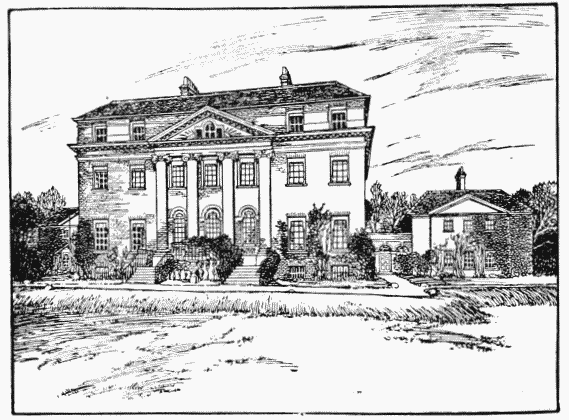
Calcot House, Tilehurst: South Front
The Great Western railway (Berks and Hants section) crosses the parish of Theale, with a station a short distance south-east of the village. In the parish remains have been found indicating that it was a site occupied probably by successive British, RomanoBritish and Saxon settlements. (fn. 8) Various relics have been dug up, including British urns, fine hand-made pottery, tiles, loom-weights, &c. A drinking cup of the Bronze Age has also been found in Theale. (fn. 9)
MANORS
The manor of TILEHURST is not mentioned in the Domesday Survey, but it is possible that it was included with other hamlets in the manor of Reading. (fn. 10) This seems more probable, since in 1291 (fn. 11) Tilehurst is enumerated among the hamlets of Reading. Tilehurst came into the possession of Reading Abbey before the 13th century, and the manor was held by the abbey until the dissolution of the greater monasteries. (fn. 12) In 1545 (fn. 13) Henry VIII granted it to Francis Englefield. He was attainted and forfeited his lands in 1585, and in the following year (fn. 14) Elizabeth granted a lease of the manor of Tilehurst for forty years to Humphrey Foster and George Fitton, but she kept the fee simple until 1599–1600, when she sold it to Henry Best and Francis Jackson, (fn. 15) from whom it passed to Thomas Crompton, son and heir of Sir Thomas Crompton, kt., of Benington, Herts. (fn. 16) He sold it in 1604 to Sir Peter Vanlore, (fn. 17) to whom Francis Englefield, the nephew and heir of the former lord of the manor, who had died in exile about 1596, quitclaimed it in 1604. (fn. 18) A few years later James I (fn. 19) made grants of a fee-farm rent in the manor, with a water-mill and other rights there, that had been reserved by Queen Elizabeth in her patent to Best and Jackson. Tilehurst passed like Sir Peter Vanlore's other property to his son and daughters as joint heirs. There are many conveyances by his children and grandchildren, (fn. 20) but for many years no partition took place amongst them. Eventually the descendants of the younger Sir Peter Vanlore seem to have obtained possession of the whole manor and were in seisin in 1676. (fn. 21) The first Vanlore built himself a house at Tilehurst, and this seems to have been occupied by the Zinzan family, who appear to have held the manor and settled at Tilehurst. (fn. 22) Sir Peter's daughter Jacoba and Henry Zinzan, her husband, (fn. 23) were buried in Tilehurst Church in 1677 and 1676 respectively; they had several children in 1665, Henry being the heir. (fn. 24) In 1685 (fn. 25) James Dickenson and his wife Jane held a moiety of the manor and in 1686 (fn. 26) John Jacques, clerk, and his wife Frances held another moiety; Jane and Frances may perhaps be identified as the daughters of Henry and Jacoba. (fn. 27) In 1687 it was sold to John Wilder of Nunhide for £1,075. (fn. 28) The manor is also said to have been in the hands of the Kendricks of Whitley, Reading, (fn. 29) who were connected with the Zinzans, and had owned land in the parish since the early 17th century, (fn. 30) but they cannot have held it for long. By 1706, however, the manor undoubtedly came into the possession of Benjamin Child, (fn. 31) who married Mary Kendrick, the heroine of the ballad of the Berkshire Lady, the daughter and co-heir of Sir William Kendrick, the last baronet. (fn. 32) After her death Benjamin Child sold it about 1759 (fn. 33) to John Blagrave of Southcot, who built Calcot House, which has passed with the manor, the old Vanlore house having been pulled down. The manor passed to his niece and devisee Frances, the eldest daughter and co-heir of Anthony Blagrave. She married John Blagrave of Watchfield, who was, however, said to have no connexion with the Blagraves of Southcot. Their descendant, Mr. Henry Barry Blagrave, is the present lord of the manor of Tilehurst.
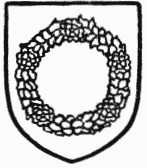
Vanlore. Or a garland in its proper colours.
An estate in the parish known formerly as Diles and at the present time as Prospect Hill, (fn. 34) which belonged to Sir William Kendrick, bart., was not sold with the manor to John Blagrave but it was inherited by Benjamin Child's eldest daughter. By her marriage it passed to James Hill, but it was sold before 1813 to John Engelbert Liebenrood, (fn. 35) in whose family it remained until Major Engelbert Liebenrood sold it to the Reading Corporation for a public park.
The Abbot of Reading held view of frankpledge (fn. 36) and exercised the rights of free fishery in the Kennet and of free warren. These rights were all exercised by his successors in the manor. (fn. 37)
The Vachells of Coley, who were free tenants of the abbey, also had the right of free warren in their demesne lands in Tilehurst (see below), a privilege obtained in 1346 (fn. 38) by John Vachell.
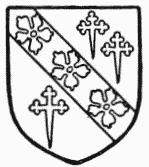
Kentwood of Tilehurst. Or a bend between three crosslets fitchy sable with three cinqfoils or upon the bend.
The manor of KENTWOOD was held of the abbey of Reading, (fn. 39) and afterwards of Sir Peter Vanlore (fn. 40) under the manor of Tilehurst, but its early history is obscure. A family taking their name from Kentwood, in the north of Tilehurst parish, were settled there in the 14th century, Nicholas Kentwood being one of the parishioners of the church of Tilehurst in 1341–2. (fn. 41) He was succeeded by John Kentwood before 1392, (fn. 42) and in 1434 the latter, or a younger John Kentwood, (fn. 43) appears in a list of the gentry of the county. His successor appears to have been Nicholas, whose wife's name was Maud (fn. 44); it seems probable that he may be identified with that Nicholas Kentwood who married Maud Sackville of Fawley, Bucks. (fn. 45) Nicholas died before 1443, (fn. 46) and was succeeded by a son named Robert and grandson John. (fn. 47) The latter granted the family property in Cholsey in 1484 (fn. 48) to Alexander Cheyne and his wife Florence, who was probably the widow of Robert Kentwood. John Kentwood died in 1487, (fn. 49) when his manors in this county seem to have been divided between his two sisters and coheirs. (fn. 50) One of these co-heirs was Elizabeth the wife of John Swafield, and the other was apparently Frideswide the wife of Richard Fettiplace of Maidencote. (fn. 51) Presumably Frideswide and Richard had died before 1507, (fn. 52) and their right in the manor had passed to their son and heir William. The latter and his wife Elizabeth seem to have made a settlement of their moiety of the manor of Kentwood in that year, (fn. 53) the trustees for the settlement being Robert Brudenell, a justice of the King's Bench, and Lewis Pollard, serjeant-at-law. (fn. 54) John Swafield and his wife Elizabeth, the tenants of the other moiety of the manor, were in seisin in 1509, (fn. 55) when they granted their interest in it to John Yate, Edmund Bury and Robert Hide, (fn. 56) probably trustees of James Yate and his wife Mary, who owned it in 1526. (fn. 57) James and Mary granted it to William Fettiplace in that year with a quitclaim from the heirs of Mary. (fn. 58) From this time the whole manor of Kentwood was held by the Fettiplace family. Nicholas the son of William Fettiplace died in 1569, (fn. 59) and the manor passed on the death of his wife Elizabeth, on whom it was settled for life, (fn. 60) to his only daughter Anne. (fn. 61) She married Edmund Dunch, (fn. 62) and her descendants in the male line held Kentwood Manor until the death of Edmund Dunch in 1719, (fn. 63) when his property was divided between co-heirs.
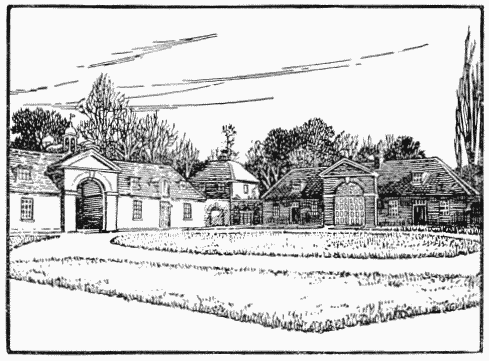
Calcot House Stables, Tilehurst
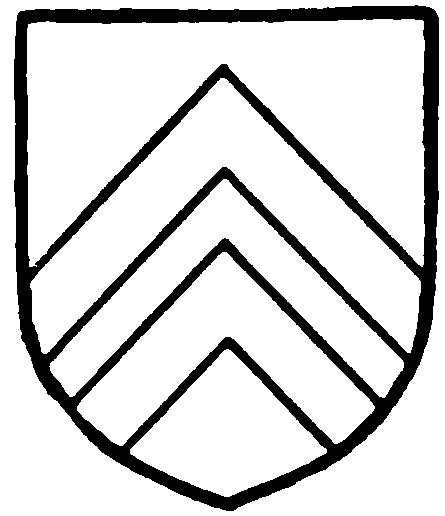
Fettiplace. Gules two cheverons argent.
The lords of Kentwood apparently held no court for their tenants in the 17th century, for they and their freeholders went to the court baron of Tilehurst. (fn. 64).
The Abbot of Reading had a free warren at Kentwood appurtenant (fn. 65) apparently to his manor of Reading.
The farm or manor of PINCENTS takes its name from a family which lived in Tilehurst in the 14th century. They came from Sulhamstead and obtained their land in Tilehurst by an exchange between the Abbot of Reading and Edmund son of Gilbert Pincent in 1316, the latter obtaining three messuages, 3 virgates and 3½ acres of land, 10 acres of meadow and 12 acres of moor in Tilehurst in place of the land hitherto held by him in Sulhamstead. (fn. 66) Edmund Pincent is mentioned as a parishioner of Tilehurst in 1341–2, but from that date (fn. 67) until the close of the 15th century it seems impossible to trace the history of the estate. In 1494–5 (fn. 68) Margaret Sambourne, a widow, died seised of the manor, which she seems to have held by inheritance, and not in right of her husband, Walter Sambourne. Her father's name was Thomas Drew, (fn. 69) who presumably had been seised before her. She was succeeded by her son Drew Sambourne, (fn. 70) who held Pincents Manor at his death in 1506–7 (fn. 71); it passed to his granddaughter Margaret, the heir of his son William, who had predeceased him. (fn. 72) Margaret married Sir William Windsor, Lord Windsor, (fn. 73) and Pincents Manor descended to their grandson Henry Lord Windsor, (fn. 74) who sold it in 1598 (fn. 75) to Anthony Blagrave. It descended with Southcot Manor, and was held in 1708 by Anthony Blagrave, (fn. 76) whose son John Blagrave was holding it presumably when he purchased Tilehurst Manor, for it is now in the possession of Mr. H. B. Blagrave.
Pincents Manor was held under the Abbots of Reading for an annual rent of 18s. and suit of court once a year. (fn. 77)
The so-called manor of BEANSHEAF, now in the parish of Theale, was held under the Abbot of Reading (fn. 78) by fealty, and after the Dissolution under the manor of Tilehurst in free socage. (fn. 79) The rent in 1514–15 was £1 9s. 8d., and the tenant paid 12d. a year to the abbot apparently to be quit of suit of court. (fn. 80) It took its name from a family living in Tilehurst in the 13th century. Robert Beansheaf (fn. 81) and his wife Joan held a messuage and 1 carucate of land in Tilehurst, for their lives, of John de Drokenesford, clerk, (fn. 82) with reversion to John and his heirs. In 1316 (fn. 83) John Beansheaf granted land in Tilehurst to John Stonor, who was already a tenant of other land in the parish. Whether this grant included the whole of the Beansheafs' holding does not appear, but their name is not found again amongst the tenants at Tilehurst. John Stonor, chief justice of the Common Pleas, (fn. 84) died in 1354 (fn. 85) seised of one messuage and 1 carucate of land held of the Abbot of Reading. He was succeeded by his son John, (fn. 86) who died in 1361 (fn. 87) also seised of land in Tilehurst, but the name of Beansheaf is not given to their property until 1390, (fn. 88) when Ralf Stonor granted the manor of Beansheaf to William Sutton of Campden, and John Frank, clerk. The latter afterwards released his right in the manor to Ralf, (fn. 89) and the Stonors held the manor throughout the 15th century. Sir William Stonor, son of Thomas, died seised of Beansheaf in 1494, (fn. 90) and it passed to his son John, (fn. 91) who died leaving no children. (fn. 92) The manor passed to his sister Anne the wife of Sir Adrian Fortescue. (fn. 93) Part of the Stonor inheritance passed to a younger branch of the family, represented by Sir Walter Stonor, and there appears to have been some difficulty in settling the respective rights of Sir Adrian Fortescue (fn. 94) and of this younger branch in Sir William's estates. Beansheaf Manor, however, was retained by Sir Adrian Fortescue and his wife (fn. 95) and was held by a lessee at an annual rent of £7 8s. 4d., and it descended to their daughter and heiress Margaret. (fn. 96) She married Sir Thomas Wentworth, who was created a baron in 1529. (fn. 97) Their son and heir Thomas second Lord Wentworth (fn. 98) succeeded his father in 1551 and sold the manor in 1562 (fn. 99) to John Bolney and Ambrose Dormer; from them it seems to have passed to the Vachell family, (fn. 100) who had been settled in Tilehurst parish certainly since the 13th century. (fn. 101) Thomas Vachell died seised of Beansheaf in 1610 (fn. 102) and was succeeded by his nephew Sir Thomas Vachell, kt. At the present day Beansheaf Farm belongs to Mr. H. B. Blagrave.
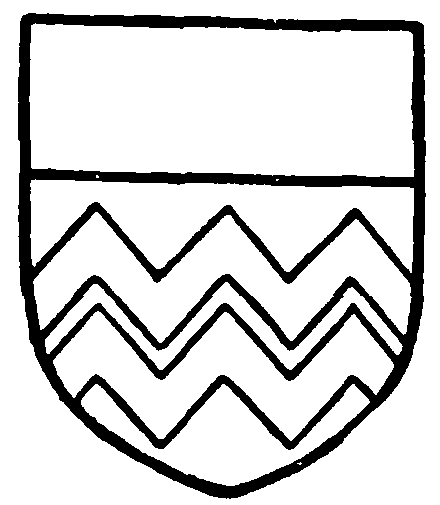
Stonor. Azure two bars dancetty or and a chief argent.
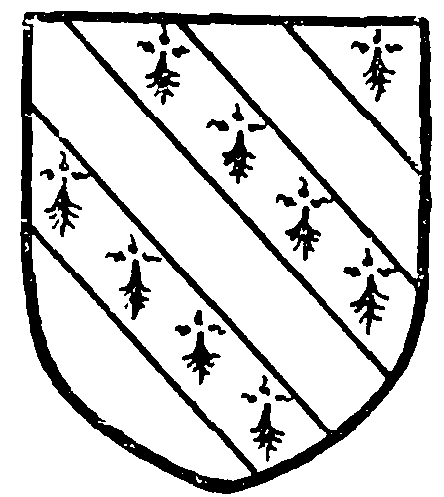
Vachell. Bendy ermine and azure.
Calcot Mill, now in Theale parish, was held by the abbey of Reading, apparently as parcel of the manor of Tilehurst. (fn. 103) After the dissolution of the abbey it came into the hands of the king, who in 1543 leased it to John Drewe for twenty-one years. (fn. 104) Two years later, however, Calcot Mill was granted with the manor to Sir Francis Englefield, (fn. 105) Drewe's lease being safeguarded, but after the forfeiture of Englefield's lands it does not seem to have been leased with the manor. Queen Elizabeth granted a water-mill in Tilehurst to Robert Earl of Essex in 1593 on a lease of twenty-one years. (fn. 106) It appears to have been included in the grant in fee of the manor of Tilehurst to Henry Best and Francis Jackson in 1599–1600, (fn. 107) for in 1613 (fn. 108) James I made a grant of a reserved fee-farm rent to William Whitmore and Jonas Verdon, payable to the manor for the water mill for three 'Eights,' containing 1½ acres, for fishing there and for perquisites of the court of the manor. At the present day Calcot Mill is the only mill in Theale parish and there is no mill in Tilehurst.
CHURCHES
The parish church of ST. MICHAEL consists of a chancel, nave, north and south aisles, west tower, north vestry and south porch.
The only ancient portion of the present church is the south aisle, which apparently dates from the late 13th or early 14th century. The tower is of the 18th century, and before alteration must have resembled closely the towers of Basildon and Brightwell Churches. The whole of the rest of the church was rebuilt, and a west door and windows were inserted in the tower in 1856, from the designs of G. E. Street. With the exception of the tower, which is of brick, the walls are faced with squared flints with Bath stone dressings and the roofs are tiled.
The chancel has a five-light east window, one window and a doorway in the north wall, and two windows in the south wall. The pointed chancel arch springs from corbels. The nave has a north arcade of three bays of pointed arches carried on quatrefoil piers and a south arcade of two low pointed arches supported on an octagonal central pier and semi-octagonal responds, the north aisle being longer than the south. There are three windows in the north wall with a doorway to the west of them, and one window in the west wall of the north aisle. Over the doorway in the east wall of the north aisle leading to the vestry is a rose window.
The east window of the south aisle is of late 13th or early 14th century date. It is of three uncusped lights with intersecting mullions under a pointed head, and has both internal and external moulded labels. In the south wall is an original window of two uncusped lights under a pointed head and high up in the west wall is a single pointed light.
The 18th-century tower, which is built of red and purple bricks, is of three stages with a crowning parapet surmounted at the angles by pinnacles. The modern Gothic doorway and windows were inserted in 1856. Over the tower is a modern octagonal stone spire with four projecting lights. The tower arch is pointed and in the west wall of the ground stage is a modern pointed doorway. The two-light window in the north wall was inserted in 1906. The ringing stage is lighted by three trefoiled openings, and in each face of the bell chamber is a two-light window with moulded brick jambs under a pointed head.
In the floor at the east end of the south aisle is a brass of Gavin More and Isabella his wife, both of whom died in 1479. Gavin was the son of Richard, one of the marshals of the king's court. Above the inscription are the figures of the man and his wife and below it those of three sons and two daughters kneeling.
At the east end of the south wall is an elaborate altar-tomb commemorating Sir Peter Vanlore, a native of Utrecht, who died in 1627, and his wife, with their life-sized recumbent effigies. The base is panelled in black marble and has a moulded plinth and carved capping. In the back of the recess which contains the tomb is a black marble slab with a long rhyming epitaph. On either side of the recess are flat pilasters with arabesque ornament, at the bases of which kneel two small figures, at the east that of a man, and at the west that of a woman. In front of the plinth kneel eight small figures of daughters in groups of three, two, and three, all holding skulls in their left hands. In the folds of the dress of the centre figure of the third group, of which the head is lost, lies a chrisom child. The spandrels of the arch of the recess are of black marble, and above the cornice of the monument are three shields of arms, the central one displaying (1 and 4) Vanlore: (2) Gules a lion passant argent, (3) Argent a cheveron between horseshoes sable, and surmounted by a crest of a negro's head. The shield at the east is (1 and 4) Dodington: Azure a fesse between two molets in the chief and a cheveron in the foot, all or, (2 and 3) Argent a lion gules. That at the west is Vanlore impaling Dodington. The group of shields is flanked by obelisks above the pilasters.
There is a ring of eight bells, the first six being by Henry Bagley of Reading, 1723; the seventh and tenor are modern.
The plate consists of a silver-gilt chalice with a cover paten stamped with the date letter of 1573, a silver-gilt flagon of 1737, and a silver-gilt almsdish of the same date.
The registers previous to 1812 are as follows: in the first volume the names are partly entered in alphabetical order: (i) all entries 1630 to 1715, also a loose page containing entries of all names beginning with 'F' from 1559 to 1641; (ii) all entries 1716 to 1754, baptisms and burials to 1775; (iii) marriages 1754 to 1786; (iv) marriages 1786 to 1812; (v) baptisms and burials 1776 to 1812.
The church of ST. GEORGE, now within the borough of Reading, consists of a chancel with an apsidal termination, north organ chamber and vestry, a nave in four bays, a north aisle and a northwest porch. Surmounting the east gable of the nave is a bellcote containing one bell. The church was built in 1881, but the chancel was enlarged in 1893. The building is of red brick with a tiled roof and is lighted by lancet windows. The north arcade of the nave has pointed arches, carried on circular red sandstone pillars, while built into the south wall is a similar arcade, to be utilized when a south aisle is added at some future date; the archway at the east end of this prospective aisle is already built. Over the chancel is a wooden vault, while the nave has an open-timber roof.
The Jacobean pulpit was originally in St. Andrew's Church, Sonning, from which church it was rejected some years back when a modern one was built. It was eventually found in a stable in a very dilapidated condition and given to St. George's, where it was again put to its original use. It is hexagonal with arcaded arabesque panels and has been very much restored, the base on which it stands being modern.
The church of the HOLY TRINITY, Theale, consists of an apsidal chancel, with an octagonal vestry on the north, nave, west porch and a detached tower at the south-east. The church, which is an interesting example of the early Gothic revival, was consecrated in the year 1832. A few years subsequently the tower was added, and in the year 1892 the present apsidal termination of the chancel was erected from the designs of Mr. J. Oldrid Scott. The design of the west front was based on that of Salisbury Cathedral, the detail of which has been copied throughout the building.
The apse is semi-octagonal, and is lighted by lancet windows. The colour decoration was designed by the late G. F. Bodley. The nave is ceiled with a plaster vault in six bays, springing from stone vaulting shafts, carried down to the floor. In each bay of the walls on either side are coupled lancet windows. At the west end is a gallery supported by two rows of stone columns, with moulded capitals and base, the eastern or front row having clustered shafts, from which spring pointed arches. The soffit of the gallery is groined in plaster.
The tower is in three stages, the belfry being lighted by triple lancet windows. Crowning it is a moulded parapet, with pinnacles at the angles. The tower is connected with the south wall of the chancel by a narrow range of buildings of similar height, lighted on the east and west sides respectively by two lancet windows.
On the north side of the chancel is the chantry of William of Wayneflete, the founder of Magdalen College, Oxford, removed hither from the chapel of that college in 1830, and now inclosing the cenotaph of Mrs. Sophia Sheppard, at whose expense the church was erected. The chantry is a long, narrow structure, about 9 ft. in height, roofed by a four-centred barrel vault with moulded ribs. In the south side are two windows, the eastern of five and the western of two cinquefoiled lights with tracery within square heads. The doorway has moulded jambs and a straight-sided four-centred arch within a square head with traceried spandrels. On the west side is a traceried panel similar to the windows. Above this is a shield of Wayneflete's arms.
The doorway to the vestry and a doorway built into the interior face of the north-west wall of the nave appear to be of similar date, and were probably brought here from Magdalen College chapel at the same time.
ADVOWSON
The church of Tilehurst was probably granted to the abbey of Reading at the same time as the manor, but the first evidence of the gift is a charter of Hubert Walter Bishop of Salisbury (1189–93), confirming various churches to the abbey. (fn. 109) The vicarage had been instituted before the date of the charter. (fn. 110) The rectory belonged to Reading until its dissolution, but the last abbot had granted it, together with the tithes, on a lease of sixty-one years to Richard Tomyowe. (fn. 111) In 1540 (fn. 112) the lessee obtained from the Crown a new lease of the tithes, together with a fishery in the Kennet which had belonged to the cellarer. The rectory was purchased at the same time as the manor (fn. 113) by Sir Francis Englefield, (Tomyowe's lease being safeguarded), and he is said to have given back the rectory to the church of Tilehurst for the celebration of masses and obits. (fn. 114) Being returned as appropriated to superstitious uses, the rectory was forfeited to the Crown in the first year of Elizabeth's reign, but in 1586–7 she again conveyed the tithes to the living, (fn. 115) from which they have not since been separated.
The advowson of the rectory and vicarage was forfeited with the other possessions of Sir Francis Englefield on his leaving the country. (fn. 116) Queen Elizabeth granted it to Thomas Crompton, Robert Wrighte and Gelly Meyricke in 1589. (fn. 117) It passed (see East Ilsley) into the possession of Uriah Babington, who died seised of it in 1605–6, (fn. 118) leaving his son Uriah as his heir. The younger Sir Peter Vanlore claimed to be patron of the living, although the advowson is not mentioned in the quitclaim (fn. 119) given by the younger Francis Englefield. Sir Peter, the father, however, is said to have obtained it from Crompton, Fuller and Brewster, who conveyed to him the manor. No opposition was offered by the Crown to Sir Peter Vanlore's obtaining the advowson, but many complications (fn. 120) and a long lawsuit arose owing to the rector, Dr. Bowle, holding the living 'in commendam' after becoming Bishop of Rochester. (fn. 121) On his death the Crown in consequence claimed the right of presentation and Dr. John Littleton was appointed. (fn. 122) At the same time the younger Sir Peter Vanlore, the patron, presented one Andrew Blackwell, (fn. 123) who appears to have been instituted. The case was taken to the House of Lords by Sir Peter, since he could not obtain redress, as he said, in the court of Common Pleas. (fn. 124) Blackwell was dismissed from the benefice before 1644 (fn. 125) and Dr. Littleton was put in possession, but owing to his delinquency during the Commonwealth Blackwell again obtained possession of the living in 1644. (fn. 126) He was, however, not recognized by the heirs of Sir Peter Vanlore, who claimed the right of presentation, and in 1658, a year after the death of Dr. Littleton, they appointed Simon Louth, (fn. 127) although the bishop could not institute him. In 1660 both claimants petitioned the Crown for the confirmation of their respective titles to the living, (fn. 128) and Simon Louth was successful, being apparently presented a new by Thomas Levingston and others, as co-heirs of Sir Peter Vanlore and by the Crown. (fn. 129) On the death of Simon Louth the Crown again presented, (fn. 130) but about that date the advowson came into the possession, presumably by purchase, of a Mr. Walker. (fn. 131) In 1743 William Best, D.D., presented, and in 1769 Edward Wise and Benjamin Walker. (fn. 132) Thomas Walker was rector and owner of the advowson and sold it to his brother-in-law, John Taylor. The latter sold it before 1799 (fn. 133) to the Rev. Thomas Sheppard, D.D., who presented both in 1799 and 1810 (fn. 134); on the second occasion the living was given to his brotherin-law, Dr. Routh, (fn. 135) the President of Magdalen College, Oxford. By his will Dr. Sheppard provided that the advowson should pass to the President and Fellows of Magdalen College, Oxford, unless otherwise devised by his widow. She died intestate, so that it passed to the college, to which it now belongs. (fn. 136)
The new ecclesiastical parish of St. George, Tilehurst, was formed in 1882, parts of Tilehurst and Theale being assigned to it. (fn. 137) It was endowed out of the Common Fund with £50 a year at the time of its formation. The benefice is a vicarage, in the gift of the Bishop of Oxford, but in 1889 the parish was incorporated with the borough of Reading. A chapel, probably that of St. John Baptist at Theale, is mentioned in 1291, (fn. 138) when it belonged to the nunnery of Goring and was worth £8. Probably it existed early in the reign of Henry III, when the prioress held land in Theale. (fn. 139) At the later date her land was said to be at Tilehurst instead of Theale. It was connected with Englefield Church, to which a payment is still made from the estate. At the time of the Dissolution it seems possible to recognize the chapel in the following entry amongst the Goring property: 'Sullam Ferme … with the Freholde Chappell grounds and tenamentts there yn ye parychys of Sullam, ye Vele and Nyffylde.' (fn. 140) The nunnery also received the yearly offering of 12d. to 'Seynt John Baptyst at ye Vele yn ye cownty of Bercks.' (fn. 141) In 1542 the manor of Sulham, with its appurtenances in Tilehurst and elsewhere, formerly belonging to Goring Priory, was granted to Richard Andrews and Leonard Chamberlain, and although there is no mention of the chapel (fn. 142) it was included in the grant, since in the following year Richard Hayles and Leonard Chamberlain granted it to the Burgoyne family for three lives. The Burgoynes sold it in 1545 to Richard Bartlett, and in 1587 Richard Bartlett of East Compton sold the chapel property to Humphrey Foster of Aldermaston. Sir William Foster sold the lands in 1609 to Anthony Blagrave of Sonning and the Wilder family purchased it in 1632. The chapel is last mentioned in 1675, (fn. 143) but it afterwards fell into decay and had disappeared in the beginning of the 19th century. (fn. 144) Foundations, however, have been found near the entrance gates of the churchyard. (fn. 145)
The present church of Holy Trinity at Theale was built by Mrs. Sheppard, while her brother, Dr. Routh, was vicar of Tilehurst. The living is in the gift of Magdalen College, Oxford.
CHARITIES
It was recorded on the table of benefactions, dated in 1731, that a Mr. Wheat had given a rent-charge of £1 10s. out of land known as Halls Farm, Silchester, for the purchase of great-coats. The rent-charge is paid by Mr. Henry Welch Thornton, the owner of the property charged, and is expended in the purchase of reefer coats, which are given periodically to aged men past work.
Church Lands.
— It appears from the recital in a deed dated 16 November 1597 that in the reign of Henry VIII, at the cost of the parishioners, two almshouses, one church-house, a house for the parish clerk, a smith's forge, and two other houses had been built upon a parcel of land upon the south side of the parish church. In 1850 the site of two cottages was added to the churchyard. The trust property now consists of a parish room, four cottages of the annual value of £28, which together with the rent of 3 r. 24 p. at North Street, Theale, known as the Church Pightle, let at £1 5s. a year, is applied towards the church expenses.
The Poor's Land containing 28 a., or thereabouts, was acquired by an award, dated 26 February 1817, made under an Inclosure Act, (fn. 146) the rents and profits to be laid out in fuel among the poor residents occupying lands and tenements under the yearly value of £10; the net income, averaging £50 a year, is distributed in coal among the poor of Tilehurst and Theale who come under the necessary qualification. By the same award certain allotments containing in the aggregate 1 a. 2 r. 27 p. were made for public purposes.
Tilehurst School.
—The school building bears an inscription under the date of 1819 recording that it 'was erected by Sophia, widow of Thomas Sheppard D.D. of Amport, on land given by the Rector of Tilehurst for the use of a National School, to be supported by charitable subscriptions and has an annual benefaction of £36 10s… . to be paid by Magdalen College Oxford.' The college in addition holds a sum of £568 8s. 5d. consols in trust for Tilehurst School, producing £14 4s. a year.
Mary Lyne's Almshouses.
—In 1851, by indenture dated 11 January (enrolled), Mary Lyne gave a piece of land, on which she erected six cottages to be used as almshouses, which the founder endowed with £4,000 consols. The inmates were to be chosen, three from the parish of Burghfield and three from the parish of Tilehurst, and were to be widows without encumbrances, or unmarried, of sixty years or upwards belonging to the Church of England and of respectable character. The endowment now consists of £4,940 16s. 6d. with the official trustees (including a gift in 1884 by the Rev. John William Routh of £200 consols), producing an income of £123 10s. 4d. Each inmate receives an allowance of 5s. a week with an additional 30s. a year for clothing, three-quarters of a ton of coal, and is expected to attend divine service regularly.
Ecclesiastical district of Theale: The School.
— In 1814 the Rev. Thomas Sheppard, D.D., by a codicil to his will proved in the P.C.C. 23 March, gave the annual sum of £20 for ever for the establishment of a school at Theale in the parish of Tilehurst 'to learn poor children to read …and to instruct them their duty to God as taught by the church catechism, and our excellent Liturgy.' The annuity is received from Magdalen College, Oxford, and applied towards the repairs of the school buildings. Under a deed of 14 May 1889 the college also holds a sum of £88 9s. 4d. Bank stock, producing yearly £7 19s. 2d., as a repair fund for the church of the hamlet of Theale.
Ellerton's Charity.
—The Rev. Edward Ellerton, D.D., curate in charge, who died in 1851, is supposed to have purchased land containing 8 a. 2 r. 38 p. let as garden allotments. The charity is now governed by a scheme of the Charity Commissioners of 21 April 1899. The rents of the allotments, averaging £11 a year, are applied in accordance with the scheme in aid of the coal and clothing clubs and in prizes to the holders of the best cultivated allotments.
On 30 March 1835 a sum of £55 was deposited in Reading Savings Bank, given by an unknown donor, for a charitable society. The sum with accumulations of interest now amounts to £117 14s. 11d., and the interest is distributed in tea among the poor by the rector, 1 lb. to each recipient.
There is also a sum of £30 in the same bank, left by will of Edward Allen, proved in the P.C.C. 20 December 1836, the interest to be distributed in bread about Christmas among the poor
The parish is in possession of two cottages near the church, which are let at £14 6s. a year, and the income is applied in aid of the general fund of the parish council.